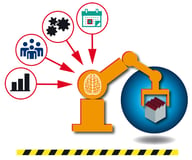6 Important Industry 4.0 Statistics to Know
Brian Hoey - June 21, 2018

One of the most crucial facets of the Industry 4.0 revolution is the integration of more robust data analytics into industrial processes. The idea is that by utilizing data in a thoughtful manner driven by specific business goals, businesses will be able to gain new insights into their workflows and potentially add value. As businesses have begun to adopt this mindset the results have frequently been promising—but why should data be relegated to complex analytics processes? In the spirit of turning data into insights, here are six important statistics about Industry 4.0 to consider as you navigate the complexity of the modern supply chain.
$28 billion
The amount of expected cost reduction in the automotive sector between 2016 and 2020 due to Industry 4.0. This number represents a 3.9% reduction in costs per annum across the auto industry; the average expected reduction across all industries was 3.6%. But where will all of these reductions in cost come from? Simply put, the heightened degree of connectivity inherent in Industry 4.0 systems lends itself to increased efficiency and a decrease in silos. As existing operational workflows become integrated with advanced analytics, many will become smarter and more lean, with some becoming entirely automated in the process.
Source: https://themarketmogul.com/industry-4-0-next-industrial-revolution/
2.6%
The annual reduction in inventory levels expected from Industry 4.0 adoption. This number digs a little deeper into the specifics of how Industry 4.0 can reduce costs, demonstrating the power of connected, cyber-physical systems to illuminate areas of waste. When it comes to inventory management in particular, smart factory frameworks typically give planners the ability to track inventory levels in real-time, utilizing either industrial internet-of-things (IIoT) devices or automated scanners to create a digital copy of their warehouse. In this way, and with a more complete and thorough account of their value chain overall, planners can pinpoint excess stock and manage their inventories in a smarter manner.
Source: https://www.symantec.com/content/dam/symantec/docs/solution-briefs/industry-4.0-en.pdf
30%
The increase in productivity that could be achieved by first wave IIoT adopters. This is combined with a 30% drop in maintenance costs, partially due to predictive maintenance scheduling. The IIoT is, of course, a crucial element of the fourth industrial revolution, paving the way for processes that can self-monitor and self-correct while transmitting a steady flow of data to other machines and users within the system. Not only can IIoT sensors on machines track usage and gather data that can be used to feed machine learning algorithms that can predict and proactively schedule maintenance downtime, they can help to more synergistically integrate information technology (IT) with operational technology (OT).
Source: https://www.accenture.com/us-en/insight-industrial-smart-production
2 Years
The amount of time expected, as of 2016, for companies that invest in Industry 4.0 to see their investments returned. This is hardly surprising, given the above facts about inventory reduction and productivity increases, but it’s especially noteworthy because most significant IT improvement projects come in noticeably late and over-budget. That Industry 4.0 systems yield such a quick, measurable ROI speaks to the extent to which these new processes are not just a shiny new IT infrastructure, but a radical reimagining of the modern factory.
Source: https://themarketmogul.com/industry-4-0-next-industrial-revolution/
More than double
The percentage of manufacturers expected to be highly digitized by 2020 compared to 2016, an increase from 33% of businesses to 72%. Though it’s difficult to put an exact figure on the number that have become more digitized in the past two years, we can safely assume that in that time there has been a significant increase in the number of manufacturing businesses making meaningful strides towards an integrated, digitized supply chain. Given the numbers we’ve seen above, it’s no surprise that more and more operations are expected to take this important step towards Industry 4.0 readiness.
27%
The number of manufacturers making significant progress with the adoption of IIoT into their production processes as of 2015. This number more or less resonates with the statistic above, but it should hammer home the notion that, for all of the optimism on display about the rise of the fourth industrial revolution, there’s still a long way to go before the requisite increases in connectivity and the integration of cyber-physical systems into the supply chain are even remotely universal. As a result, this period of partial adoption presents certain paradoxes for eager supply chain managers. On the one hand, it’s too early to reap the full benefits of an integrated supply chain, owing to the fact that many potential suppliers will lack the necessary IT infrastructure to provide desired levels of visibility and flexibility. On the other hand, there is still a competitive advantage to be gained for early adopters of these new, increasingly prevalent technologies.
If you want to learn more get your Guide to Industry 4.0:
LATEST POSTS
- Understand Circular Economy in The Manufacturing Industry
- How Can Industry 4.0 IT Integration Be Achieved Smoothly?
- The Significance of Order Sequencing in Discrete Manufacturing
- How to improve your Supply Chain Management: The Power of Control Towers
- Optimizing Human Resource Scheduling in Manufacturing: A Technological Approach



